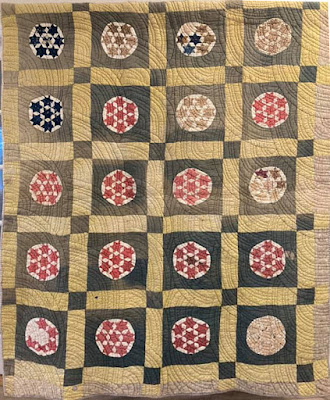#4 Thoroughbred Horse by Denniele Bohannon
Albany, New York's state capital, was known for horse racing in the second half of the 19th century. We recall the women of Albany and their work for Union soldiers with a thoroughbred horse as no New York appliqued album is complete without a horse.
Quilt dated 1879 for Ann Elizabeth Davis,
New York project & the Quilt Index
Albany's Army Relief Association held a well-documented fund-raising fair
in 1864 in a specially-built building in one of the city's parks.
The Library of Congress owns an album full of photographs
taken at that fair with a focus on the women who ran the
various booths.
The Albany Army Relief Bazaar opened on February 22, 1864,
Washington's Birthday.
The Bazaar's biggest coup was a raffle for one of two autograph copies of Abraham Lincoln's Emancipation Proclamation.
Emily Peck Weed Barnes (1827-1889)
Emily Weed Barnes persuaded the President to donate a copy. Or she asked her
father to persuade him.
I think this is Emily with a hand to her brow at the Bazaar.
That may be a sister to the right. They have their father's nose.
Brady Studios portrait Thurlow Weed (1797-1882)
the Republican party.
Republicans measuring Lincoln's shoes for an 1864
Presidential candidate; Thurlow Weed probably to the
right of the right shoe.
Emily's husband William Barnes, Albany attorney and anti-slavery activist, was also active in founding the Republican Party in the mid-1850s. William was in charge of the raffle. Tickets cost $1. Abolitionist Gerrit Smith, who was on the committee, wound up with the document and sold it to New York State where it remains in Albany today (the only copy now because the other burned in the great Chicago fire.)
Read more about the Proclamation here:
The workers at the Autograph and Photograph
booth pose for a picture. They sold pictures like
this as fundraisers. And autographs like
Herman Melville's whose cousin was a fair organizer.
See a post on this headdress worn by many female workers.
http://civilwarquilts.blogspot.com/2018/06/patriotic-headdress.htmlLocal people dressed up as foreigners in exotic
costume to run the booths. (Have not been able to
find a photo of the Holland booth which had
a quilting frame set up.)
Women at the Yankee Booth. I'll take that model
of the Washington monument made out of pearl buttons, please.
All in all it was an event and raised about $83,000 for Soldier's Aid.
Emily on the left. Must be her (or one of her two sisters) on the right.
And I think I figured out why this woman, if she was Emily Weed Barnes, was looking a little weary in late winter, 1864. She gave birth to her fourth child Harriet on March 21st.
Thoroughbred Horse by Becky Brown
The Block
A few months after the peace Winslow Homer published a sketch
of fans at the Saratoga track in Harper's Weekly
New York has long been known as Horse Country. Albany is just a few miles from Saratoga Race Course, founded in 1863, one of the country's best-known thoroughbred tracks.
https://friendsofalbanyhistory.wordpress.com/2018/01/23/the-albany-army-relief-bazaar-for-civil-war-aid-and-the-emancipation-proclamation-1864/
http://www.nysl.nysed.gov/ep/acquisition.htm
Thoroughbred Horse by Barbara Schaffer
Our block is based on horses found in numerous New York albums.
Horses by needleworkers of varying skills
Like the cows in Block #2, horses were much pictured in the media of the day.
1861
Horses to work, to show and to race.
One wouldn't have to look far for equine inspiration.
Horse Races 1868 Albany
The Pattern
How to print:
- Create a word file or a new empty JPG file that is 8-1/2" x 11".
- Click on the image above.
- Right click on it and save it to your file.
- Print that file out 8-1/2" x 11". Note the inch square block for reference.
- Adjust the printed page size if necessary.
- Add seams.
Thoroughbred Horse by Bettina Havig
My poor horse is more of a farm horse. I put his
mane on upside down and he's not prancing but
plodding. He is however all dotted.
Stella Rubin had this quilt for sale in 1993
Extra Reading
More about the Emancipation Proclamation manuscript:https://friendsofalbanyhistory.wordpress.com/2018/01/23/the-albany-army-relief-bazaar-for-civil-war-aid-and-the-emancipation-proclamation-1864/
http://www.nysl.nysed.gov/ep/acquisition.htm
Currier & Ives prints often featured horses.























































